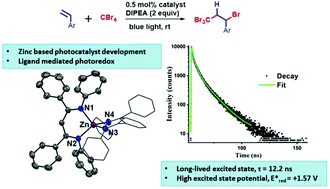Visible light photoredox by a (ph,ArNacNac)2Zn photocatalyst: photophysical properties and mechanistic understanding†
Abstract
A class of potent zinc-based photocatalysts have been developed in this report, whose reducing properties are dependent on the ligand redox of the beta-diketiminate backbone. Two molecules have been crystallographically characterized to reveal that zinc is trapped in a tetrahedral environment posed by two beta-diketiminate backbones. Upon excitation with blue light, the molecules generate a relatively long-lived excited state in the range of ∼12 nanoseconds as determined by a time-correlated single photon counting experiment. The long-lived excited state is reductively quenched by an amine and the reduction is a ligand-based process. Stern–Volmer quenching kinetics was performed to find a linear correlation of the reduced fluorescence intensity with increasing quencher concentration that suggests a dynamic quenching process. Under photochemical conditions, the radical anion of the zinc complex transfers a single electron to break a C–Br bond and conducts atom transfer radical addition (ATRA) type reactions. Leveraging on the single electron transfer from the reduced backbone further, a Meerwein arylation reaction has also been developed. A plausible mechanistic pathway has been delineated for ATRA reactions, depending on the gathered evidence and appropriate intermediate isolation.



 Please wait while we load your content...
Please wait while we load your content...